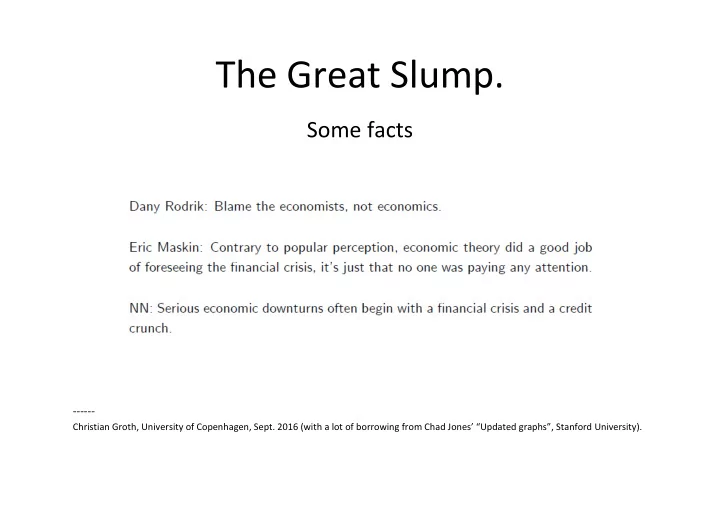

The Great Slump. Some facts ------ Christian Groth, University of Copenhagen, Sept. 2016 (with a lot of borrowing from Chad Jones’ “Updated graphs”, Stanford University).
The S&P 500 Stock Price Index (real) Real Stock Price Index (ratio scale) 2560 1280 640 320 160 80 1920 1930 1940 1950 1960 1970 1980 1990 2000 2010 Year Source: Robert Shiller, http://www.econ.yale.edu/~shiller/data.htm Chad Jones, Updated Graphs – January 12, 2015 – p. 25
Bubbles in the stock market? P/E Ratio 45 40 35 30 Average = 16.3 25 20 15 10 5 0 1880 1900 1920 1940 1960 1980 2000 Year Source: Robert Shiller, http://www.econ.yale.edu/~shiller/data.htm Chad Jones, Updated Graphs – January 12, 2015 – p. 26
Bubbles in housing prices? Real Home Price Index (1953=100, ratio scale) 200 180 Decline of 35.7 percent 160 peak to trough 140 120 100 1950 1960 1970 1980 1990 2000 2010 Year Source: Robert Shiller, http://www.econ.yale.edu/~shiller/data.htm Chad Jones, Updated Graphs – January 12, 2015 – p. 27
Fig 10.7: U.S. Economic Fluctuations since 2000 Short−run output, Ytilde +4% +3% +2% +1% 0 −1% −2% −3% −4% −5% −6% −7% −8% 2000 2005 2010 2015 Year Source: Federal Reserve Economic Data Chad Jones, Updated Graphs – January 12, 2015 – p. 6
Fig 10.8: U.S. Unemployment Rate Percent 10 9 8 7 6 5 4 3 2000 2005 2010 2015 Year Source: Federal Reserve Economic Data Chad Jones, Updated Graphs – January 12, 2015 – p. 7
GDP. Denmark, Eurozone, and the US. Denmark Eurozone 100 United States 90 80 70 1996 1998 2000 2002 2004 2006 2008 2010 2012
Risk spreads in interbank lending http://www.bloomberg.com/apps/cbuilder?ticker1=.TEDSP:IND TED Spread: difference between the 3-month LIBOR rate and the 3-month U.S. treasury yield Chad Jones, Updated Graphs – January 12, 2015 – p. 20
Dropping the Fed Funds rate to zero Percent 7 6 5 4 3 2 1 0 2000 2005 2010 2015 Year Chad Jones, Updated Graphs – January 12, 2015 – p. 19
Fig 14.1: Ten Year Bond Spreads 10 9 BAA Corporate Bond Yield 8 7 6 5 4 10−Year Treasury Yield 3 Spread 2 1 1996 1998 2000 2002 2004 2006 2008 2010 2012 2014 Year Chad Jones, Updated Graphs – January 12, 2015 – p. 21
Fig 14.8: The Fed’s Use of Unconventional Policies Source: http://www.clevelandfed.org/research/data/credit_easing/index.cfm Chad Jones, Updated Graphs – January 12, 2015 – p. 23
Fig 10.10: Inflation in the U.S. Dec 2007 = 2.4% Dec 2010 = 0.6% Percent Nov 2014 = 1.7% 6 All items 5 4 3 2 Excluding food 1 and energy 0 −1 −2 2000 2005 2010 2015 Year Source: Federal Reserve Economic Data Chad Jones, Updated Graphs – January 12, 2015 – p. 9
Economic policy in the Great Recession Laissez-faire implies risk of long duration of the slump, hence: 1. high youth unemployment , 2. high long-term unemployment. Both have adverse e ff ects not only for people directly harmed, but also for the e ff ective labor supply in the future (dequali fi cation, demotivation). Monetary policy Conventional monetary policy ine ff ective due to the lower bound on i. Alter- natives: • Quantitative easing . • Adopting a higher in fl ation target in the Taylor rule until return to boom? Makes sense, but: credibility problem because CBs are known for their distaste of in fl ation.
Expansionary fi scal policy Is powerful in a liquidity trap, spending multipliers high, both C p and I p likely to be raised because: a. no fi nancial crowding out, b. helps to reduce precautionary saving, c. less risk of a Fisher-Tobin-style de fl ationary spiral. Adverse e ff ect on the long-run situation, B g /Y ∗ ? Not necessarily, we have B g ↑ , but also Y ∗ ↑ because of: (i) the problems 1 and 2 from previous page mitigated, (ii) public investment in infrastructure and education may contribute to overall productivity.
Recommend
More recommend